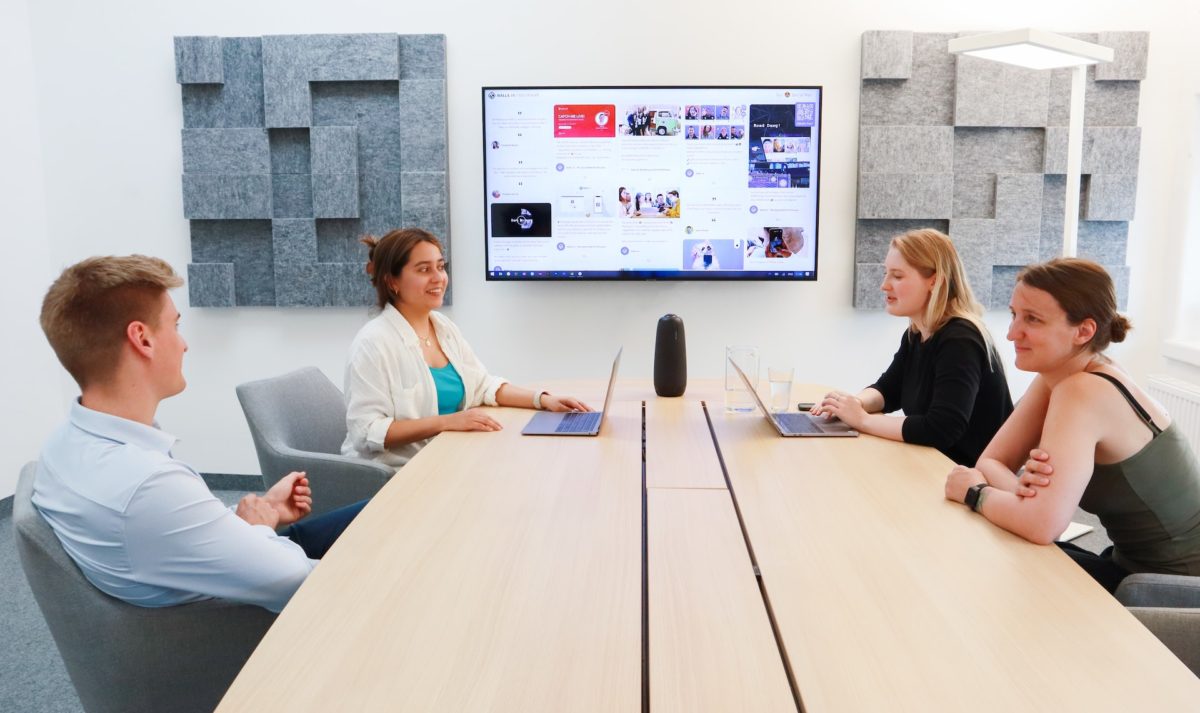Have you ever wondered how brands like Apple, Starbucks, and Netflix manage to achieve worldwide recognition and success? The secret lies in their global strategy.
Building and developing a brand is a difficult, engaging and time-consuming task, but it is also extremely rewarding. It is definitely worth putting in as many hours of hard work as possible, to later watch how your company continually achieves new goals, wins over customers and becomes one of the leaders in its industry. What is brand development, and how should you start implementing it in your business to make sure it is ahead of the competition?
Definition of brand development
Before we describe the brand development stages and give you some tips on what brand planning looks like, we should first define the basic concepts – let’s start with the definition. All signs, symbols, names, terms, logos, graphic designs and messages (or combinations of all these elements) are a part of the brand. Their purpose is to make identifying goods, services or remembering the companies on the market easier for the customers. Economic benefits for the owner are of course the main purpose of building a brand. The definition of brand development is difficult to find in an unambiguous form. It can be best described as all activities aimed at building awareness of the brand among consumers and encouraging them to use its services or purchase its goods.
Brand development – make your company stand out
It is difficult to single out specific features that influence the perception of brands as better or worse. It is necessary to constantly adapt to the market rules, as they are extremely dynamic and can quickly become obsolete. However, there are a few key aspects that set companies apart and allow you to constantly develop a brand. Those are:
- high-quality products / services that should be the basis of all brand activities;
- developing a brand in accordance with consumers needs and expectations, and at the same time paying attention to any feedback coming from them (positive and negative);
- large capital that can be allocated to various development sectors, e.g. production or marketing
- diverse offer;
- constant expansion of services / product range;
- multi-level communication with customers
How to start?
Now that you know what you are aiming for and what brand development is, it is time to get down to business. We have prepared for you five basic steps that every business owner must go through in the initial phase when developing their brand.
Consumer insight
At the beginning of your journey, you absolutely have to perform an in-depth analysis of the purchasing needs of consumers within the industry in which you operate – that’s what consumer insight is. It shows you why specific people buy certain products or use selected services. Your brand has to be the answer to customers’ expectations, frustrations and problems. Its purpose should be not only to help in solving various issues, but also to make their life easier and to provide new possibilities.
For example, the Nike brand and its slogan “Just do it” is a response to the lack of motivation to engage in physical activity and an incentive to try things that the recipients would like to do, but for some reason postpone that decision. Their sports clothes are to be the first step that will allow you to start a new, active life or make it possible to fulfill your dreams blocked by human fears or stereotypes. What is more, this advertising slogan has been in use since the 1980s and grows with the brand and the world around us. Although the words are still the same, their interpretation is constantly changing.
Neglecting consumer insight research is one of the common marketing issues that can lead to a lack of understanding of the target audience, resulting in ineffective marketing strategies and missed opportunities for growth.
Brand development – growth potential analysis
The next step in brand development is a thorough analysis of your options. You need to know the strong and weak sides of your company. Do not rely entirely on your judgment and perform an in-depth interview with the representatives of various age / customer groups. You should know what the public awareness of your industry is, as well as the services or products that you offer or intend to offer. Remember to confirm what kind of resources you have – both tangible (i.e. capital and durable goods) and intangible (your competences, employees’ competences, etc.). Do not forget to identify what you lack and try to find a way to fill those gaps.
How to develop a brand – competition analysis
The next step is to analyze what your competitors are doing and if it brings profits. If, for example, you are developing a brand of a beauty salon that operates stationary in a specific town, you have to take into account other businesses with the same or similar profile in the vicinity of several or even several dozen kilometers. Why? In today’s world, time is the most important currency and we want to save as much of it as possible. That’s why we often choose service locations in the closest area. However, if there is a place where we can do something cheaper or better, time (in this case related to travel) will not play such a big role. On the other hand, if you want to operate online, you need to carefully analyze how all similar brands operate in your country’s market. Here are some of the things you should consider when analyzing the competition:
- service packages / product range,
- price list,
- marketing communication (the kind of advertisements they use, where they advertise, etc.),
- channels of communication with clients (e.g. social media),
- all other, even the smallest, aspects appropriate for a given business (e.g. in the case of a beauty salon, this would be: booking systems used by the competition, what signboards they have, promotions they offer to the customers, etc.).
Build brand strategy
What’s next? The next step is very difficult and requires a lot of knowledge and time. You need to create a complete brand development strategy. All the information that you obtained during the preliminary analysis will now be very useful. How to develop a brand strategy?
- Write down strengths and weaknesses of your company
Here you should summarize everything that you did in step two. Take into account both the external and internal branding strategy. It is also a good idea to include in this section a summary of the competition analysis, what will work to your brand’s advantage or disadvantage.
- Specified long- and short-term goals of the brand, built on the basis of the SMART concept.
What does that mean? Any goal you set in front of your brand must be specific, measurable, achievable, relevant and time-bound. Constructing goals in accordance with this concept will not only make it easier to describe your goals, but above all, you will be able to plan the execution activities precisely and then carry them out.
- Target group
When building corporate branding strategy, it is necessary to create accurate profiles of your brand’s ideal customers – the so-called persona. Usually, it is not possible to create one “persona” that will represent everyone from the target group, in most cases you will end up with at least 10, if not more. Personas are imaginary people (or characters inspired by people we know) that represent our dream clients. All of them have names, interests, needs, expectations, things they like to do, professional and material status, marital status etc. Such visualization and tangible presentation of the ideal consumer will facilitate the creation of communication, marketing messages, as well as profiling services or creating offers promoting new products.
- Communication with customers
Communication with customers is crucial in building a successful brand as it helps to understand customer needs, build trust and loyalty, create brand advocates, manage brand perception, resolve issues, provide support, and adapt to changing customer needs. You need to analyze all the available channels that will enable you to reach consumers and build their brand awareness or make them come back again – remember to choose the ones that are most suitable for your target audience.
- Marketing strategy and goals
The goals defined earlier apply to the company as a whole, but it is also important to describe the way in which marketing messages will be carried out to potential customers. So you need to determine not only where, when and in what form your company’s ads will appear, but also what message they should carry. Any ad created without a specific purpose, even if fortunately yielding some results, will not give you any basis for assessing its effectiveness.
- Budget
You need to know what financial resources you have to help you run the brand development process. Once you know the exact amount, it will be necessary to divide and assign it to individual sectors, starting with the high-priority ones and ending with those less important.
Brand identity development
When talking about building a brand, we have to mention brand identity development as well. It is an extremely important aspect. What is brand identity? It is a set of features that creates a positive image of your brand and makes your business’ products and services easy to distinguish from those offered by your competitors. Brand identity is the fundamental basis on which effective brand management strategies are built.
Brand identity is created by the owner, employees and even the customers. It is worth remembering that the process of brand identity development is continuous – it’s happening even without your input. With time, the brand identity of your company will have to evolve, as you need to adapt it to the changing world and consumer behavior. Brand identity is made up of both visible and invisible elements. The first group includes, among others: logotype, colors, graphic design (e.g. website or promotional materials), used icons and fonts, office decor, product design, and even outfits that your employees’ wear. That is what we call visual identification of the brand. The invisible elements are, among others, customer service quality and manner, organizational culture or corporate social responsibility.
Brand visual identity – examples
Do you think that the logotype or colors used are not as important as people say? If they are not important, then why seeing a burning fox makes you immediately think about the FireFox browser, and why after you notice a green-red-yellow circle with a blue dot inside, you know perfectly well that you will be using the Chrome browser?
It is similar to choosing a restaurant while driving on a highway. If you are a fan of the McDonald’s brand, you will surely be attracted by two golden arches faster than the charming old man known from KFC visual identification.
Another example may also be a clothing or shoe industry. There is a reason as to why you can observe the clashes of the largest companies producing shoes such as Adidas, Nike or Puma. Each of these brands has its huge crowds of fans that have clung to them not only because of the quality of their products, but also thanks to the great visual identification. Their well-managed brand identity is visible not only at the level of the logo or colors, but also at the level of the footwear appearance.
Now you know what your first steps in building a strong brand should look like. However, you must remember that brand development strategies are different and should be adjusted to the nature of the business, consumer needs and changes in the market. If you want to develop your brand, our brand audit checklist will be helpful. Are you afraid that you will not be able to cope with this task yourself? We are here to help you! Use our branding services and see for yourself how your business changes and grows!






